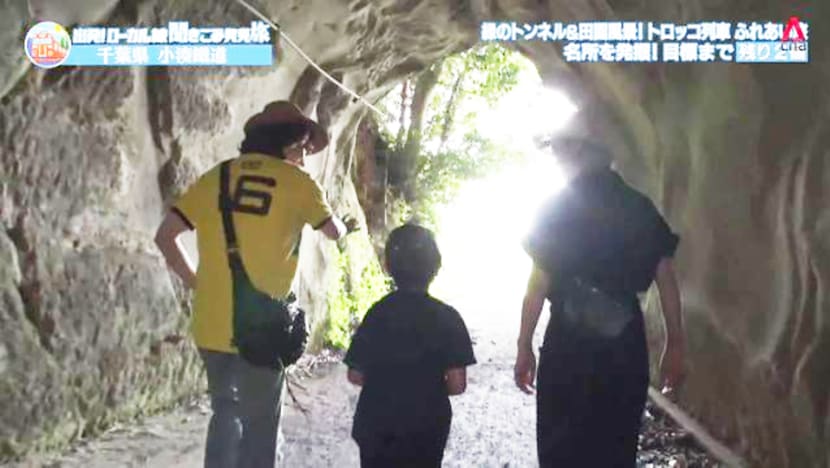Road Trip On Kominato Tetsudo - Part 2
Highlights this week include an art museum beside Lake Takataki, Kominato Railway's popular tourist trolley train, a hand-dug tunnel and a temple linked to the founder of the Kamakura shogunate.

Our two-day journey on the Kominato Line in Chiba Prefecture continues. On the first day, we advance all the way to Takataki Station and spend the night at the Sakaya guest house. The next morning, we are driven to Takataki and catch the 9.55pm train to Satomi Station. We want to take the trolley train to Yoro Valley from here. It only departs at 12pm so we make use of the time to enquire about the area’s recommended spots. We go to a store that sells lunchboxes and are told about the Ichihara Lakeside Museum. We rent some bicycles and ride for 15 minutes to the museum. It displays the works of sculptor Katsuyuki Shinohara, known as KUMA. It also holds contemporary art exhibitions and workshops for kids and adults.
There is an Italian restaurant on the museum grounds called Bosso. It is known for its pizza and gelato made with ingredients from Chiba, such as Yachimata peanut gelato with waffles. Chiba is the largest producer of peanuts in Japan and those from Yachimata have a rich taste and sweetness.
We go back to the station and ride on the trolley train. It is a modern version of a steam locomotive that was used in the past. The Boso Satoyama Trolley is the Kominato Railway's most popular sightseeing train. We reach Tsukizaki Station at 12.10pm and meet the Honorary Station Master. He has been working for Kominato Railway for more than 40 years and is now around 90 years old.
We have until 1.15pm to explore the area and someone at the Yamazaki Shop tells us about a popular hand-dug tunnel called Eishoji. There are many mountains here, so people living in this area dug tunnels in the past to pass through them. We go to the 142-metre-long Eishoji Tunnel, which was dug in 1898 using an ancient Japanese digging method called Kannonbori. The tunnel’s shogi-like shape distributes the mountain's weight to both sides, preventing the tunnel from collapsing.
We return to Tsukizaki Station and catch the train to Yorokeikoku Station. The journey takes 10 minutes and we reach at 1.25pm. The next train from here will depart at 4.15pm. We ask a local about places to see in Yoro Valley. We are told the Shusse Kannon Temple is famous as it brings luck in love and one’s career. Its official name is Yorozan Rikkokuji. It however takes 30-40 minutes to reach there by foot so we visit the Tourist Association to get information. We find out that the next bus to the valley is only at 2.20pm, but it is also accessible by bicycle. So we rent some bikes and reach the place after cycling for less than 10 minutes.
A red Kannon Bridge arched bridge over the Yoro River leads to the temple and is a symbol of Yoro Valley. We cross the bridge and visit the shrine office to find out about the temple’s history. We learn that it is connected to Minamoto no Yoritomo. When he lost the battle of Ishibashiyama, he came to Chiba Prefecture, with the assistance of the Miura family. He brought a statue of Kannon to this place and prayed for recovery. He later established the Kamakura shogunate and became the first shogun.
After visiting the main shrine building, it is already 3.05pm and we are hungry. We go to Kissa Fuji, run by a couple. We have some spaghetti before riding the electric bikes back to Yorokeikoku Station. We then hop on the 4.15pm train and head to Kazusa-Nakano, the last station of this trip. We arrive after five minutes and a local we meet suggests we check out a mineral spring with brown “gas water”, which is believed to be good for the skin.
The gas accumulated on the seabed dissolves in groundwater and springs out. The iodine in the water has a disinfectant effect, helping to treat conditions such as dermatitis. This area has a gas well and was the first place in Japan where water-soluble natural gas was discovered in the middle of the Meiji era. There is a pipe that discharges the water and some residents bring their bottles to collect the water. In the past, grandparents would boil this water for a bath and use it to prevent the kids from getting a heat rash.
Tips:
1) You can rent a bike at some stations to get to sightseeing spots
2) Boso Satoyama Trolley is Kominato Railway's most popular sightseeing train










